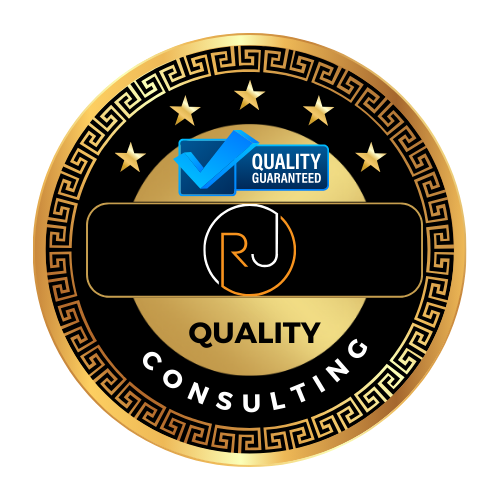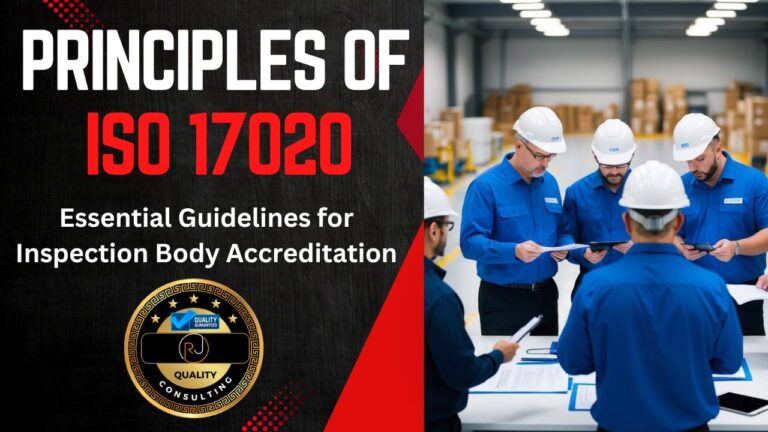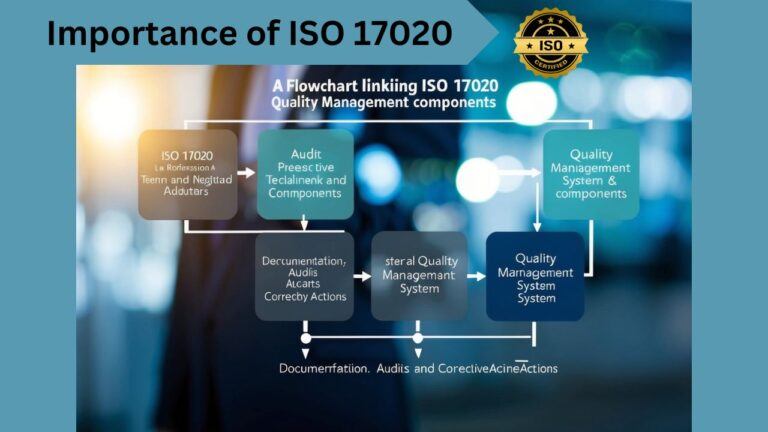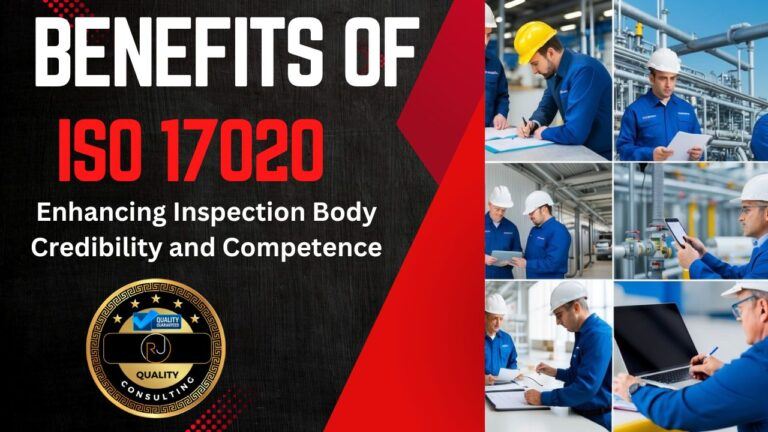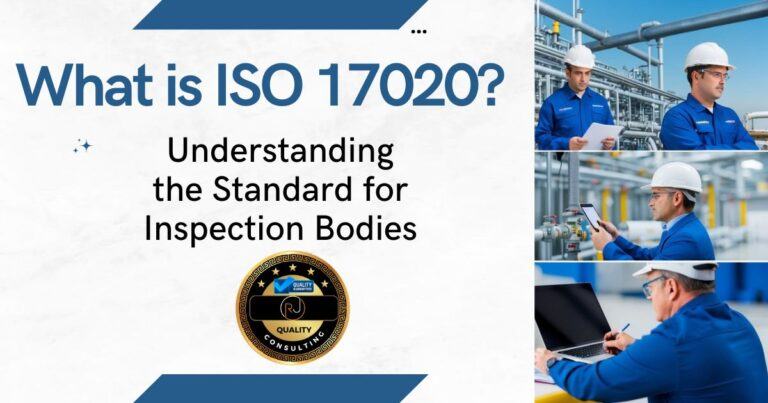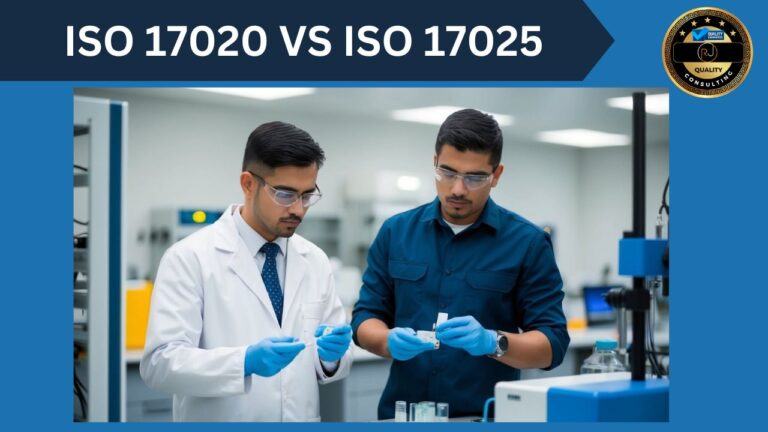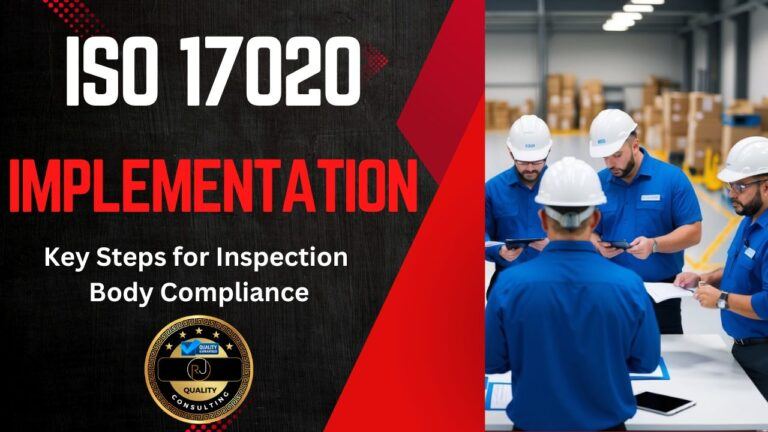ISO 17020 vs ISO 9001: Key Differences in Quality Management Standards
ISO 17020 and ISO 9001 are two important standards that help organizations manage quality. Many people wonder which one they should choose for their business. Let’s look at ISO 17020 vs ISO 9001 and see what makes these standards different and how they can help you.

ISO 17020 is made for inspection bodies, while ISO 9001 is for general quality management. ISO 17020 sets rules for how inspection groups should work and stay fair. ISO 9001 gives a wider set of guidelines for quality control in any type of business.
Both standards can help improve your work, but they have different goals. ISO 17020 focuses on making sure inspections are done right. ISO 9001 aims to make all parts of a business run better. Picking the right one depends on what your company does and what your customers need.
📘 ISO/IEC 17025 Quality Manual Template
Accelerate your lab’s accreditation process with our comprehensive Quality Manual Template, designed to align with ISO/IEC 17025:2017 standards.
- Fully editable and customizable to fit your laboratory’s needs.
- Includes all necessary procedures, forms, and policies.
- Structured to facilitate easy implementation and compliance.
- Developed by experts with extensive ISO/IEC 17025 experience.
Key Takeaways
- ISO 17020 is for inspection bodies, ISO 9001 is for general quality management
- Choosing between them depends on your business type and customer needs
- Both standards can help improve work quality and customer satisfaction
Overview of ISO 17020 vs ISO 9001

ISO 17020 and ISO 9001 are two important standards for quality management and inspection. They focus on different aspects of quality assurance but share some common goals.
Definition and Scope of ISO 17020
ISO 17020 implementation sets requirements for inspection bodies. It covers how they should operate to ensure consistent and impartial inspections. The standard applies to various types of inspection organizations.
Key points of ISO 17020 include:
- Ensuring inspector competence
- Maintaining impartiality in inspections
- Using proper inspection methods
- Keeping accurate records
ISO 17020 aims to build trust in inspection results. It helps inspection bodies prove they can do their job well.
Definition and Scope of ISO 9001
ISO 9001 is a broader standard for quality management systems. It can be used by any organization, regardless of size or industry. The standard helps businesses improve their processes and satisfy customers.
ISO 9001 focuses on:
- Meeting customer needs
- Improving product and service quality
- Enhancing customer satisfaction
- Continual improvement of processes
Many companies use ISO 9001 to show they have good quality practices. It can help them win new business and keep existing customers happy.
Purpose and Outcomes

ISO 17020 and ISO 9001 have different goals and results. ISO 17020 focuses on inspection bodies, while ISO 9001 applies to quality management across industries. Both standards aim to improve processes and boost trust.
Intended Outcomes of ISO 17020
ISO 17020 aims to ensure inspection bodies work fairly and consistently. It sets rules for how these bodies should operate. The standard helps inspection bodies:
- Stay unbiased in their work
- Follow clear procedures
- Produce reliable results
- Build trust with clients
ISO 17020 also focuses on the competence of inspectors. It requires ongoing training and evaluation. This leads to more accurate inspections and reports.
Intended Outcomes of ISO 9001
ISO 9001 targets broader quality management goals. It applies to many types of organizations. The standard helps you:
- Meet customer needs better
- Improve product and service quality
- Boost efficiency in your processes
- Reduce waste and cut costs
ISO 9001 emphasizes leadership involvement and risk-based thinking. It promotes a culture of continuous improvement. This can lead to higher customer satisfaction and better business results.
Requirements for Accreditation

ISO 17020 and ISO 9001 have different requirements for accreditation. ISO 17020 focuses on inspection bodies, while ISO 9001 applies to quality management systems across various industries.
ISO 17020 Accreditation Requirements
To get ISO 17020 accreditation, inspection bodies must show they’re impartial and competent. You need to prove your staff has the right skills and knowledge. Your inspection methods must be reliable and consistent.
Set up a solid management system. This includes clear policies and procedures. Keep good records of all inspections and results.
Show how you handle complaints and fix problems quickly. Make sure your equipment is well-maintained and calibrated.
Prove you can keep information confidential. Set up ways to identify and manage risks to your impartiality.
ISO 9001 Quality Management System Requirements
For ISO 9001 certification, you need a strong quality management system. Start by defining your quality policy and goals. Make sure top management is involved and committed.
Set up processes to meet customer needs. Keep track of how well you’re doing and always try to improve.
Train your staff and make sure they understand their roles. Keep good records and control your documents.
Plan for risks and opportunities in your business. Set up ways to handle non-conforming products or services.
Regularly check your system with internal audits. Review your performance and make changes when needed.
Management System Structure – ISO 17020 vs ISO 9001

ISO 17020 and ISO 9001 have different management system structures tailored to their specific purposes. ISO 17020 focuses on inspection bodies, while ISO 9001 applies to quality management across industries.
Structure for Inspection Bodies in ISO 17020
ISO 17020 requires inspection bodies to have a clear management system. You need to set up processes for document control and record keeping. This helps you track inspections and maintain consistency.
Your quality manual should outline your policies and procedures. Make sure it covers all aspects of your inspection activities.
Internal audits are key. You must regularly check if you’re following your own procedures. This helps find areas for improvement.
Management reviews are also important. Your top leaders should meet to discuss the system’s effectiveness. They can then make decisions to enhance it.
Structure of Quality Management System in ISO 9001
ISO 9001 has a broader structure for quality management. You start with a quality policy that sets your overall direction.
Your quality manual describes how you meet ISO 9001 requirements. It should cover all parts of your business that affect quality.
Document control is crucial. You need a system to manage your procedures and work instructions.
Internal audits help you check if you’re following your processes. They also spot chances to get better.
Management reviews let your leaders assess the system. They look at data like customer feedback and audit results. This helps them make choices to improve quality.
Operational Differences

ISO 17020 and ISO 9001 have distinct operational focuses. ISO 17020 centers on inspection activities, while ISO 9001 deals with quality management systems. Let’s look at how these standards differ in practice.
Inspection Activities Under ISO 17020
ISO 17020 sets rules for inspection bodies. It covers how they check products, processes, and services. Key points include:
- Inspection methods must be clear and documented
- Staff need proper training and qualifications
- Equipment must be well-maintained and calibrated
- Inspection reports should be detailed and accurate
Inspection bodies must stay unbiased. They can’t let outside pressure affect their work. ISO 17020 also requires them to follow relevant laws and regulations.
QMS Processes in ISO 9001
ISO 9001 focuses on quality management systems (QMS). It applies to many types of organizations. Main areas include:
- Setting quality goals and planning how to reach them
- Defining roles and responsibilities
- Managing resources and infrastructure
- Controlling documents and records
- Monitoring customer satisfaction
You need to check and improve your QMS regularly. This helps make sure it stays effective. ISO 9001 also stresses the importance of leadership in creating a quality-focused culture.
Competence and Impartiality

ISO 17020 and ISO 9001 have different approaches to competence and impartiality. These factors play key roles in how organizations handle inspections and quality management.
Ensuring Competence and Impartiality in ISO 17020
ISO 17020 focuses on inspection bodies’ ability to perform their tasks. It requires staff to have the right skills and knowledge for their roles.
The standard asks for ongoing training to keep skills up-to-date. This helps ensure high-quality inspections.
Impartiality is a big deal in ISO 17020. Inspection bodies must avoid conflicts of interest. They need to show they can make fair decisions.
ISO 17020 also stresses the importance of confidentiality. Inspection bodies must protect sensitive information they gather during their work.
Competence and Training in ISO 9001
ISO 9001 takes a broader view of competence. It looks at the skills needed across an entire organization.
The standard asks you to identify the skills your staff need. You then need to provide training to fill any gaps.
ISO 9001 doesn’t focus as much on impartiality. Instead, it emphasizes the importance of customer satisfaction.
The standard does touch on confidentiality. It asks you to protect customer data and intellectual property.
Both standards value competence, but ISO 17020 is more specific about inspection skills. ISO 9001 takes a wider view of organizational competence.
Handling Non-Conformities

Non-conformities can happen in any organization. ISO 17020 and ISO 9001 have different ways to deal with these issues. Let’s look at how each standard handles them.
Corrective and Preventive Actions in ISO 17020
ISO 17020 focuses on fixing problems in inspection bodies. When something goes wrong, you need to act fast. First, you find the cause of the issue. Then, you make a plan to fix it. This plan is called a corrective action.
You also try to stop problems before they happen. This is preventive action. You look for weak spots in your processes. Then you make changes to strengthen them. This helps keep your inspection work accurate and fair.
ISO 17020 wants you to keep good records. Write down what went wrong and how you fixed it. This helps you learn and improve over time.
Corrective Actions within ISO 9001
ISO 9001 has a strong focus on corrective actions. When you find a non-conformity, you need to take steps to fix it. First, you control the problem to stop it from getting worse. Then you figure out why it happened.
Next, you make a plan to fix the root cause. This might mean changing a process or training staff. You put this plan into action and check if it works. If it doesn’t, you try something else.
ISO 9001 also asks you to look at your whole system. Could this problem happen somewhere else? If so, you make changes to prevent it. You keep records of all these steps. This helps you show that you’re always trying to get better.
Global Recognition and Mutual Recognition

ISO 17020 and ISO 9001 both offer ways for organizations to gain global recognition. These standards help build trust and open doors to international markets.
ISO 17020 and Global Recognition
ISO 17020 gives inspection bodies a chance to show their skills worldwide. When you get this accreditation, other countries take notice. It’s like a seal of approval that says you meet high standards.
Accreditation bodies like UKAS and ANAB check if you follow ISO 17020 rules. They look at how you work and make sure you do things right. This process can take time, but it’s worth it.
Once you’re accredited, you join a global network. Your inspections will be trusted in many countries. This can help you grow your business and work with more clients.
Mutual Recognition of ISO 9001
ISO 9001 is known all over the world. When you get this certification, it shows you care about quality. Many countries accept ISO 9001, which makes it easier to do business abroad.
The International Accreditation Forum (IAF) helps with mutual recognition. They make sure that ISO 9001 certificates are trusted everywhere. This means you don’t need to get certified in each country.
Your ISO 9001 certificate can open doors. It tells clients you meet global quality standards. This can give you an edge over competitors who don’t have the certification.
Choosing Between ISO 17020 and ISO 9001

Picking the right standard depends on your organization’s goals. ISO 17020 is best for inspection bodies, while ISO 9001 suits a wider range of businesses.
ISO 17020 focuses on inspection competence and impartiality. It’s ideal if you perform inspections for clients or authorities.
ISO 9001 covers quality management systems. It’s a good choice if you want to improve overall quality and customer satisfaction.
Consider your main activities:
- Do you mainly conduct inspections? Choose ISO 17020.
- Is quality management your priority? Go with ISO 9001.
Some key differences:
| ISO 17020 | ISO 9001 |
|---|---|
| For inspection bodies | For any organization |
| Focuses on inspection processes | Covers all quality processes |
| Emphasizes impartiality | Emphasizes customer focus |
You can use both standards if needed. ISO 9001 can help meet some ISO 17020 requirements for quality management.
Think about your clients’ needs too. Some may require specific certification. Ask them which standard they prefer.
Complementary Nature of ISO 17020 and ISO 9001

ISO 17020 and ISO 9001 can work together to improve inspection bodies. They have different focuses but share some common goals.
Integrating ISO 17020 with ISO 9001
You can use ISO 9001 to meet some ISO 17020 requirements. ISO 9001 covers quality management, which helps with parts of ISO 17020.
ISO 17020 adds specific rules for inspection bodies. It focuses on being fair and skilled at inspections.
Using both standards gives you a strong system. You’ll have good quality control and inspection practices.
This combo helps you stay accurate and reliable. It also makes your inspection processes better.
Benefits of Conjoint Implementation
Using ISO 17020 and ISO 9001 together has many good points. You’ll meet more customer needs and follow rules better.
Your inspection body will keep getting better. The standards push you to always improve.
You’ll have more trust from clients and regulators. They’ll see you’re serious about quality and fairness.
Your equipment will be more reliable. Both standards stress having good tools for the job.
If you need to check work again, you’ll have clear steps to follow. This helps keep your results consistent.
Additional Considerations for Quality and Inspection

When choosing between ISO 17020 and ISO 9001, you need to think about some key factors.
Inspection Activities ISO 17020 focuses on inspection work. It covers how you examine products, processes, and services. ISO 9001 is broader and looks at your whole quality system.
Inspection Reports Your reports matter. ISO 17020 has strict rules for writing inspection reports. ISO 9001 doesn’t go into as much detail on this.
Internal Audits Both standards require internal audits. You’ll need to check your own work regularly.
Technical Skills ISO 17020 puts a big focus on your staff’s technical skills. You must show they know their stuff. ISO 9001 cares about skills too, but not as much.
Calibration If you use measuring tools, both standards say you need to keep them accurate. ISO 17020 has more specific rules about this.
Testing Labs ISO 17020 fits well if you do a lot of testing. But if you run a full lab, you might need a different standard like ISO 17025.
Complaints Both standards want you to handle complaints well. You need a system to track and fix problems customers point out.
Frequently Asked Questions

ISO 17020 and ISO 9001 are different standards with unique purposes. Let’s look at some key questions about their requirements, benefits, and applications.
What distinguishes the ISO 17020 standard from ISO 9001 in terms of requirements?
ISO 17020 focuses on inspection bodies, while ISO 9001 covers quality management systems. ISO 17020 has specific rules for impartiality and competence in inspections. ISO 9001 is broader and can apply to many types of organizations.
What are the key benefits of being accredited under ISO 17020?
ISO 17020 accreditation shows your inspection body meets international standards. It can boost your credibility and open doors to new business. Clients often prefer ISO 17020 accredited bodies for their reliability.
What types of services fall under the scope of ISO 17020?
ISO 17020 covers many inspection services. These can include product inspections, safety checks, and regulatory compliance audits. The standard applies to bodies that examine materials, products, or processes.
How does the ISO 17020 accreditation process differ from the ISO 9001 certification process?
ISO 17020 accreditation involves a thorough review of your inspection processes. It checks your staff’s skills and your equipment. ISO 9001 certification looks at your quality management system as a whole.
What are the specific competencies necessary for an ISO 17020 type A inspection body?
Type A bodies must be completely independent. Your staff needs expert knowledge in their inspection areas. You must have systems to ensure unbiased results and protect confidential information.
In what ways do the objectives of ISO 17020 accreditation align with those of ISO 9001 certification?
Both standards aim to improve quality and consistency. They require documented processes and regular reviews. ISO 17020 and ISO 9001 both emphasize meeting customer needs and following regulations.
🕒 Book Your Free 45-Minute Consultation
Have questions about ISO/IEC 17025 or ISO 9001 implementation or accreditation? Schedule a free 45-minute consultation with me to discuss your Company or laboratory’s needs and how we can achieve compliance together.
Schedule Your Consultation